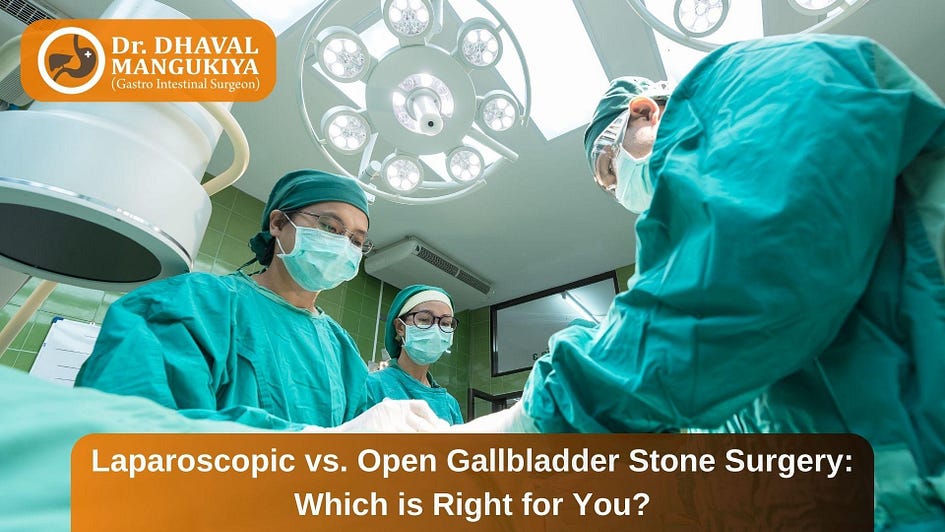Laparoscopic vs. Open Gallbladder Stone Surgery: Which is Right for You?

Gallbladder stones, also known as gallstones, are a common health issue affecting millions of people worldwide. When these stones cause significant pain or complications, surgery to remove the gallbladder (cholecystectomy) is often recommended. Two main surgical approaches are available: laparoscopic and open surgery. Dr Dhaval Mangukiya, one of the best gall bladder surgeons in Surat, sheds light on both methods, helping you understand which might be the right choice for your situation.
Understanding Gallbladder Stone Surgery
Before diving into the comparison, let’s briefly review what gallbladder stone surgery entails. The procedure, called a cholecystectomy, involves removing the entire gallbladder, not just the stones. This is because leaving the gallbladder in place could lead to future stone formation. Both laparoscopic and open surgeries achieve this goal, but they differ significantly in their approach.
Laparoscopic Cholecystectomy
Laparoscopic cholecystectomy, often referred to as “keyhole” surgery, is the most common method for removing the gallbladder today. Here’s what you need to know:
Procedure
● Small incisions: The surgeon makes 3–4 small incisions in the abdomen.
● Camera-guided: A tiny camera (laparoscope) is inserted through one incision, providing a magnified view of the internal organs.
● Specialized tools: Long, thin instruments are used to remove the gallbladder through the small incisions.
Advantages
- Minimally invasive: Smaller incisions mean less trauma to the body.
- Shorter hospital stay: Most patients go home the same day or the next day.
- Faster recovery: Many people return to normal activities within a week.
- Less pain: Smaller incisions typically result in less post-operative pain.
- Lower risk of infection: Smaller wounds have a reduced risk of infection.
- Cosmetic benefits: Smaller scars are less noticeable.
Potential Drawbacks
● Not suitable for all patients: Those with severe obesity, previous abdominal surgeries, or certain medical conditions may not be candidates.
● Slightly higher risk of bile duct injury: Though rare, this risk is slightly higher compared to open surgery.
Open Cholecystectomy
Open cholecystectomy is the traditional method of gallbladder removal. While less common now, it’s still used in certain situations, shares Dr Dhaval Mangukiya, one of the best gallbladder surgeons in Surat.
Procedure
● Large incision: The surgeon makes a 4–6 inch incision in the upper right abdomen.
● Direct access: The gallbladder is removed through this larger opening.
Advantages
- Better visualization: Surgeons have a direct view of the surgical area.
- Suitable for complex cases: Ideal for patients with severe inflammation, scarring, or anatomical variations.
- Lower risk of certain complications: Slightly lower risk of bile duct injury compared to laparoscopic surgery.
Potential Drawbacks
- Longer recovery time: Patients typically need 4–6 weeks to fully recover.
- More post-operative pain: The larger incision usually results in more discomfort.
- Longer hospital stay: Patients often need to stay in the hospital for 2–5 days.
- Higher risk of wound complications: Larger incisions are more prone to infection and hernias.
- More noticeable scarring: The larger incision leaves a more visible scar.
Which Surgery is Right for You?
The choice between laparoscopic and open gallbladder surgery depends on various factors. Here are some considerations that the best gastro surgeons in Surat would want you to understand:
- Your overall health: If you’re in good health with no complicating factors, laparoscopic surgery is often the preferred choice.
- Body weight: While laparoscopic surgery can be performed on obese patients, extreme obesity might necessitate an open procedure.
- Previous surgeries: If you’ve had multiple abdominal surgeries, open surgery might be safer due to potential scar tissue.
- Severity of gallbladder disease: In cases of severe inflammation or infection, open surgery might be necessary.
- Surgeon’s expertise: The experience and comfort level of your surgeon with each technique can influence the decision.
- Emergency situations: In urgent cases, such as gallbladder perforation, open surgery might be the faster and safer option.
- Patient preference: Your personal preferences regarding recovery time, pain tolerance, and scarring should be considered.
It’s important to note that sometimes a surgery that begins as laparoscopic may need to be converted to an open procedure during the operation. This decision is made if the surgeon encounters unexpected difficulties or complications.
Making Your Decision
Ultimately, the choice between laparoscopic and open gallbladder surgery should be made in consultation with your healthcare provider. They will consider your medical history, current health status, and the specifics of your gallbladder condition to recommend the most appropriate approach.
Remember, both procedures are well-established and have high success rates. The most important factor is addressing your gallbladder issues effectively to improve your health and quality of life.
If you’re seeking gall bladder stone treatment in Surat, don’t hesitate to ask your doctor questions about both procedures. Understanding your options can help you feel more confident and prepared for your surgical journey.
Conclusion
While laparoscopic cholecystectomy is more common for most gallbladder removals due to its minimally invasive nature and faster recovery times, open cholecystectomy remains a valuable and sometimes necessary approach. Your individual circumstances will guide the decision, ensuring you receive the most appropriate care for your specific situation.
Comments
Post a Comment